Tiger’s Nest Monastery, perched precariously on the edge of a 3,000-feet-high cliff in Paro Valley, is one of the holiest places in Bhutan. Legend has it that Guru Rinpoche [wiki], the second Buddha, flew onto the cliff on the back of a tigress, and then meditated in a cave which now exists within the monastery walls.
The monastery, formally called Taktshang Goemba, was built in 1692 and reconstructed in 1998 after a fire. Now, the monastery is restricted to practicing Buddhists on religious retreats and is off-limits to ordinary tourists.


The monastery, formally called Taktshang Goemba, was built in 1692 and reconstructed in 1998 after a fire. Now, the monastery is restricted to practicing Buddhists on religious retreats and is off-limits to ordinary tourists.



Sugriva Cave

Sanjivani Mountain from where Sanjivani Booti was acquired to save Lakshman which has many exotic herbs even now

Floating Stone from Ramsethu(bridge made by lord Rama and Vanara sena)



Ramsethu


Ma Mundeshwari Temple in Kaimur District of Bihar was recently in news due to the planned renovation and restoration by Archaeological Survey of India (ASI). Newspaper reports suggested that Mundeshwari Temple was built in 108 A D. Since then rituals and worship have been taking place at the temple without a break. Thus making it the oldest functional temple in the world.
The use of the term ‘oldest’ is a bit risky when talking about temples associated with Sanatana Dharma (Hinduism). Simply because no one has been able to clearly state how old Sanatana Dharma is. Say this temple is the oldest and immediately another person will be come with something much older.
So the safest option is to say that Ma Mundeshwari Temple in Kaimur District of Bihar is one of the oldest Hindu temples in the world.

Ma Mundeshwari Temple is situated atop the Kaimur Hill (608ft). The temple is in an octagonal shape. The sanctum sanctorum of the temple has an idol of Devi – Mundeshwari. There is also a ‘Chaturmukha Shivling’ in the sanctum sanctorum. A clear indication that Shiva and Shakti were worshipped here. Also an indication that the temple might be part of the Tantric cult which is quite popular in the Eastern part of India.
Apart from Shiva and Shakti, the temple also has idols of other popular gods in the Hindu pantheon including Ganesha, Surya, Vishnu and Mother Goddess. Temple materials and idols can be found scattered near this very rare octagonal shaped temple.
Experts believe that the temple was built during the Shaka Era.
Interestingly, the present caretaker of the temple is Muslim, yet another example of the religious harmony at the grassroots level in India. The temple attracts devotees during festivals like Ramnavami and Shivratri.






The Abode Of Lord Vishnu
Cradled in the twin mountain ranges of Nar and Narayan is the holiest of the four main shrines, Badrinath along the left bank river Alaknanda. With the splendid Neelkanth mountains as the backdrop, it is an important destination on the scared itinerary of every devour Hindu. Once the spot was carpeted with 'badris' or wild berries and hence was famous as 'Badri Van'.
Badrinath is considered the holiest of the four important shrines in Garhwal. The town is at an altitude of 3,133 m. above sea level, situated on the left bank of river Alaknanda and exactly between the two mountains Nara and Narayan. The shrine is dedicated to Vishnu, the preserver and falls in the religious itinerary of every devout Hindu.
The present temple was built about two centuries ago by Garhwal Kings. It is a conical structure, 15 m. tall and has small cupola of a gilt bull and spire. There are 15 idols in the temple complex, each sculpted in black stone. The principal idol represents Vishnu in a meditative posture and is flanked by Nara-Narayan. Legend dates it prior to the Vedic age though it is believed to have been re-established by Adi Shankaracharya, an important Hindu saint in 8th century A.D. Some of the other images include Laxmi (Vishnu's consort), Garud (Vishnu's mount), Shiva & Parvati and Ganesha.
The temple has been renovated several times due to damages by avalanches. It looks fairly modern now due to the colourful "Singh Dwara" or the main entrance gate. It has three parts- Garbha Griha (the sanctum sanctorum), Darshan Mandap (for pujas) and Shobha Mandap (for devotees to assemble). The revered shrine is still alive with myriad legends from mythology. Its sanctity is emphasised in the ancient scriptures as "There are many sacred spots of pilgrimage in the heavens, earth and the nether world, but there has been none equal to Badri, nor shall there be".
Mythological Legend
Legend has it, when the Ganga was requested to descend to earth to help suffering humanity, the earth was unable to withstand the force of its descent. Therefore the mighty Ganaga was split into twelve holy channels. Alaknanda was one of them that later became the abode of Lord Vishnu or Badrinath.
The temple of Shri Badrinathji on the banks of the Alaknanda river, dates back to the vedic times. Situated at an altitude of 3,133 mts., the present temple is believed to have been built by Adi Guru Shankaracharya- an 8th century's philosopher-saint, who also established a 'math' here. Also known as 'Vishal Badri', Badrinath is one of the Panch Badris.
Panch Badris or Five Badris
Besides the main temple of Badrinath there are four other smaller badri temples. These are collectively called the panch badris or five badris. Very few pilgrims however, visit the other four Badri temples.
Yogadhyan Badri (1920 m.)
Closest to the main temple of Badrinath lies this tiny, sleepy hamlet which remains unnoticed by most pilgrims and is the winter home for the idol at Badrinath. Pandukeshwar is also an important archaeological site. Some years ago, four ancient metal foils engraved with a description of several kings in the region were discovered here. Believed to be over 1500 years old, these foils are kept at Joshimath, 30 km downstream.
Bhavishya Badri (2,744 m.)
The bhavishya or future badri is situated at Subain near Tapovan, about 17 km east of Joshimath. According to Hindu belief, when evil is on the rise in this world, the two mountains Nara and Narayan at Badrinath will close up on each other and destroy the route to the present Badrinath. This would also mark the end of the present world and the beginning of a new one. Lord Badrinath will then appear at the Bhavishya Badri temple and be worshipped here instead of at the present one.
Bridha Badri or the 'Old Badri'
Bridha Badri or the 'old Badri' is the third temple about 7 kms short of Joshimath, on the main Rishikesh-Badrinath motor road at Animath. It is believed that Badrinath was worshipped here before its enshrinement by Shankaracharya at the main Badrinath seat. The temple of Bridha Badri is open throughout the year.
Adi Badri
Adi Badri is the farthest from the other four badris. It is approachable from Karnaprayag by a motorable road enroute Ranikhet. The temple complex has 16 small temples with intricate carvings.
Seven of these temples belong to the late Gupta period. Local tradition assigns these buildings to Shankaracharya. The main temple is distinguished by a pyramid shaped raised platform, with a black stone idol of Vishnu.
Pilgrimage Attractions in Badrinath
Badrinath Temple
On the right bank of Alaknanda lies the sacred spot perched at an altitude of 3,133 metres above the sea level. Encircled by a beautiful valley, the 15mtrs. High temple is dedicated to Lord Vishnu, it is built in the form of a cone with a small cupola of gilt bull and spire. Built by Adi Guru Shankaracharya - the philosopher-saint of the 8th century, the temple has been renovated several times due to damage by avalanches. Its colourful 'Singh Dwara' or the main entrance gate gives it a new, modern look.
The temple divided into three parts - the 'garbha griba' or sanctum sanctorum, the 'darshan mandap' where the rituals are conducted and the 'sabha mandap'where devotees assemble.The complex has 15 idols. Especially attractive is the one metre high image of Badrinath, finely sculpted in black stone. It represents Lord Vishnu seated in meditative pose.
Tapt Kund
Devotees take a holy dip in the natural thermal springs on the banks of the river Alaknanda, before entering the Badrinath Temple. The water of the kund is believed to have medicinal properties.
Hemkund Sahib (43 kms.)
Near the Valley of Flowers is the holy lake Hemkund- an important pilgrimage of the Sikhs and Hindus. Along its shores is the sacred Sikh Shrine where Guru Gobind Singh, the tenth Guru unified with God after prolonged mediation in his previous birth.
Nearby is the Lakshman Temple where Lakshman - the brother of Lord Rama performed his penance. The reflection of surrounding snow-clad peaks in its placid waters offers a scenic sight.
Brahma Kapal
A flat platform on the bank of river Alaknanda where Hindus perform propitiating rites for their deceased ancestors.
Neelkanth
A Pyramidical-shaped snowy peak towering above Badrinath, popularly known as the 'Garhwal Queen'.
Mana Village (4 kms.)
Inhabited by Indo-Mangolian tribe, it is considered to be the last Indian village before Tibet on this route. Nearby are Vyas Gufa- the rock cave of saint Ved Vyas, the writer of Mahabharata; Bhim Pul- a natural bridge over the Saraswati river and Vasundhara Falls- a 122 mts. high waterfall- all forming and important part of the pilgrimage to Badrinath.
Mata Murti Temple (3 kms.)
On the right bank of Alaknanda stands the temple dedicated to the mother of Sri Badrinathji.
Alka Puri (15 kms.)
The source of Alaknanda river from the glacier snouts of Bhagirath- Kharak and Satopanth glaciers.
Satopanth (25 kms.)
A three cornered lake with a circumference of about 1 km., situated at an elevation of 4,402 mts. above sea level. It is named ater the Hindu triad- Brahma, Vishnu and Mahesh, who are believed to occupy one corner each of the lake. The trek is hazardous with dramatic landscapes. An experienced guide is advisable. Govindghat (25 kms.)
The confluence of Alaknanda and Lakshman Ganga rivers. It has an imposing Gurudwara named after Guru Gobind Singh.
Joshimath (44 kms.)
The winter home of Shri Badrinathji is situated on the slopes above the confluence of Alaknanda and Dhauliganga. It is one of the four 'maths' established by Adi Guru Shankaracharya.
Panch Prayag
The five important confluences- Deoprayag, Nandprayag, Rudraprayag, Karnaprayag and Vishuprayag, form the Panch Prayag.
Deoprayag
The confluence of Alaknanda and Bhagirathi rivers. Ancient stone scriptures are found here. Important pilgrim spots are Shiv Temple and Raghunath Temple.
Rudraprayag
The confluence of Alaknanda and Mandakini rivers. The temples of Rudranath and Chamunda Devi are noteworthy.
Nandprayag
The confluence of Alaknanda and Mandakini rivers. The Gopalji Temple is worth a visit.
Karnaprayag
The confluence of Alaknanda and Pindar rivers with temples of Uma and Karna.
Vishnuprayag
The confluence of Alaknanda and Dhauliganga rivers. An ancient temple of Lord Vishnu stands here by a pool called Vishnu Kund.
Srinagar
The old capital of Garhwal, it is an important cultural and educational centre. Places to visit include Kamleshwar and Kilkeshwar temples and the Shankar Math.
Accessibility
Airport
Jolly Grant (317 kms.)
Railhead
Rishikesh (300 kms.), Kotdwar (327 kms.)
Road
Well connected to Rishikesh, Haridwar, Dehradun, Kotdwar and other hill stations of Garhwal and Kumaon region.



Penugonda the abode of Vasavi, situated in West Godavari District of Andhra Pradesh , India is well connected by Road and Rail.
Penugonda, the abode of VASAVI, is situated on the banks of the GAUTAMI RIVER which was one of the seven tributaries of the Sacred Godavari and it is the place where GREAT SAINTS performed YAGNA and penance. It is here the great saint Pulasthya was successful in achieving the simultaneous visual manifestation of the three deities, Brahma, Vishnu and Maheswara. Penugonda is also the place where God KUMARASWAMY (Skanda) performed penance and Guru Bhaskaracharya envisioned the manifestation of Brahma. Later on, Penugonda become the abode of Lord Lakshminarayana who went on to be known as Konakomala Jamardhana and Parvathi Parameswara who went on to become Gowrinageswara. Penugonda, Currently located in West Godawari Dt of AP known as Kasi of Arya Vysyas.
The Vysya community consisted of 714 Gotrajas who lived happily in Penugonda Kingdom under the able rule of King Kusuma Shresti and Queen Kusumamba. King Kusuma Shresti who was 16th in the line of kings who succeeded SAMADHIMUNI was childless. As per Guru Bhaskaracharya’s advice they performed ‘PUTRAKAMESTI YAGNA’.
Goddess PARASHAKTHI appeared from the HOMAKUNDAM and blessed the couple with payasam. Kusumamba consumed the payasam with devotion and on VAISHAKA SHUDDHA DASHIMI day, she gave birth to twins a boy, named Virupaksha who was an incarnation of God Nandikeswara and Vasavi, an incarnation of Goddess ADIPARASHAKTI. Virupaksha attained proficiency in Dharmashastra, politics and martial arts.
Vasavi was taught Fine Arts and Music. From her childhood, she was an ardent devotee of Lord Shiva. She was a teenage girl of exceptional beauty. She decided to dedicate her life to Lord Shiva and remain unmarried as Gowrabalika.
King Kusumashresti was a tributary King to Emperor Vishnuvardhana who visited Penugonda.
The Emperor received a rousing welcome by the King Kusuma Shresti and the people of Penugonda looked at him with awe and reverence.
Vishnuvardhana was captivated by the astounding beauty and glamour of Vasavi and decided to marry her at any cost.
His desire was like a death blow to Kusuma Shresti.
King Kusumashresti called a meeting of the elders of 714 Gotra and discussed the matter in detail. Under the guidance of Guru Bhaskaracharya, they all decided to give importance to the views of Vasavi.
Royal couple, Guru Bhaskaracharya, Vasavi and Virupaksha had a secret meeting. Vasavi at this stage told that she wanted to uphold the dignity and honour of womanhood and was born with a purpose to preach non-violence (Ahimsadharma) to the world. She exhibited her original form of Adiparashakti and vowed that she would remain a virgin.
On hearing that Vasavi had declined to marry him, Vishnuvardhana deiced to marry her even by waging a war on Penugonda. In order to prevent bloodshed and to uphold the dignity and honour of womanhood, Vasavi decided to end her AVATAR by offering herself to the God of fire – AGNI.
Out of the 714 Gotrajas, 102 Gotrajas supported her view and decided to enter the sacred fire alongwith her. Fearing persecution from Vishnuvardhana, the remaining 612 Gotrajas ran away from Penugonda to save their lives. Malhara, a great sculptor built 103 Homakundas for the sacred occasion.
On MAGHA SUDDHA BIDIGE day, Vasavi entered the Sacred Fire along with the 102 Gotraja
Vasavi emerged from the sacred fire as ‘KANYAKAPARAMEWARI’, and displayed her original form of ‘ADIPARASHAKTHI’ with eighteen hands – ASTA DASA BHUJA and preached Universal and Social Religiousness, Spirituality, Love, Sacrifice and Non-Violence and laid the foundation for Global Unity through non-violence and dharma rakshana
This day is celebrated as ‘ATMARPANA DAY’ on a large scale across all ‘VASAVI TEMPLES’. The 102 GOTRAJA COUPLES who entered the sacred fire along with Vasavi were pardoned of their curses of 16 generations and given MOKSHA by VASAVI.
This astonishing news reached Emperor Vishnuvardhana who was on his way to Penugonda and his head broke into thousands of pieces and died.
The sons of the 102 Gotra Couple who entered fire went to KASI to perform last RITES and brought 102 SHIVALINGAS and installed these SHIVALINGAS at prominent place in Penugonda city. To this date, this street is known as LINGALA VEEDHI.
Virupaksha was crowned as the King of Penugonda by Raja Raja Narendra, son of Vishnuvardhana and provided excellent facilities to the citizens to lead a happy life.
Bharath Ratna Dr. Sarvepalli Radhakrishnan, Past President of India, has indeed very rightly described Goddess VASAVI as the FIRST ever known embodiment of NON-VIOLENCE in the world. Her path of non-violence was later tread by Jesus Christ, Goutam Buddha, Mahatma Gandhi, Satya Sai Baba, Potti Sriramulu of AP and Martin Luther King.
Penugonda, the abode of Goddess Vasavi is to ARYA VYSAS, as Buddha Gaya is to Buddhists, as Shravana Belagola is to Jains. Mecca and Madeena is to Muslims and Jerusalem is to Christians.
(Courtesy from www.vasavipenugondatrust.com)
Penugonda, the abode of VASAVI, is situated on the banks of the GAUTAMI RIVER which was one of the seven tributaries of the Sacred Godavari and it is the place where GREAT SAINTS performed YAGNA and penance. It is here the great saint Pulasthya was successful in achieving the simultaneous visual manifestation of the three deities, Brahma, Vishnu and Maheswara. Penugonda is also the place where God KUMARASWAMY (Skanda) performed penance and Guru Bhaskaracharya envisioned the manifestation of Brahma. Later on, Penugonda become the abode of Lord Lakshminarayana who went on to be known as Konakomala Jamardhana and Parvathi Parameswara who went on to become Gowrinageswara. Penugonda, Currently located in West Godawari Dt of AP known as Kasi of Arya Vysyas.
The Vysya community consisted of 714 Gotrajas who lived happily in Penugonda Kingdom under the able rule of King Kusuma Shresti and Queen Kusumamba. King Kusuma Shresti who was 16th in the line of kings who succeeded SAMADHIMUNI was childless. As per Guru Bhaskaracharya’s advice they performed ‘PUTRAKAMESTI YAGNA’.
Goddess PARASHAKTHI appeared from the HOMAKUNDAM and blessed the couple with payasam. Kusumamba consumed the payasam with devotion and on VAISHAKA SHUDDHA DASHIMI day, she gave birth to twins a boy, named Virupaksha who was an incarnation of God Nandikeswara and Vasavi, an incarnation of Goddess ADIPARASHAKTI. Virupaksha attained proficiency in Dharmashastra, politics and martial arts.
Vasavi was taught Fine Arts and Music. From her childhood, she was an ardent devotee of Lord Shiva. She was a teenage girl of exceptional beauty. She decided to dedicate her life to Lord Shiva and remain unmarried as Gowrabalika.
King Kusumashresti was a tributary King to Emperor Vishnuvardhana who visited Penugonda.
The Emperor received a rousing welcome by the King Kusuma Shresti and the people of Penugonda looked at him with awe and reverence.
Vishnuvardhana was captivated by the astounding beauty and glamour of Vasavi and decided to marry her at any cost.
His desire was like a death blow to Kusuma Shresti.
King Kusumashresti called a meeting of the elders of 714 Gotra and discussed the matter in detail. Under the guidance of Guru Bhaskaracharya, they all decided to give importance to the views of Vasavi.
Royal couple, Guru Bhaskaracharya, Vasavi and Virupaksha had a secret meeting. Vasavi at this stage told that she wanted to uphold the dignity and honour of womanhood and was born with a purpose to preach non-violence (Ahimsadharma) to the world. She exhibited her original form of Adiparashakti and vowed that she would remain a virgin.
On hearing that Vasavi had declined to marry him, Vishnuvardhana deiced to marry her even by waging a war on Penugonda. In order to prevent bloodshed and to uphold the dignity and honour of womanhood, Vasavi decided to end her AVATAR by offering herself to the God of fire – AGNI.
Out of the 714 Gotrajas, 102 Gotrajas supported her view and decided to enter the sacred fire alongwith her. Fearing persecution from Vishnuvardhana, the remaining 612 Gotrajas ran away from Penugonda to save their lives. Malhara, a great sculptor built 103 Homakundas for the sacred occasion.
On MAGHA SUDDHA BIDIGE day, Vasavi entered the Sacred Fire along with the 102 Gotraja
Vasavi emerged from the sacred fire as ‘KANYAKAPARAMEWARI’, and displayed her original form of ‘ADIPARASHAKTHI’ with eighteen hands – ASTA DASA BHUJA and preached Universal and Social Religiousness, Spirituality, Love, Sacrifice and Non-Violence and laid the foundation for Global Unity through non-violence and dharma rakshana
This day is celebrated as ‘ATMARPANA DAY’ on a large scale across all ‘VASAVI TEMPLES’. The 102 GOTRAJA COUPLES who entered the sacred fire along with Vasavi were pardoned of their curses of 16 generations and given MOKSHA by VASAVI.
This astonishing news reached Emperor Vishnuvardhana who was on his way to Penugonda and his head broke into thousands of pieces and died.
The sons of the 102 Gotra Couple who entered fire went to KASI to perform last RITES and brought 102 SHIVALINGAS and installed these SHIVALINGAS at prominent place in Penugonda city. To this date, this street is known as LINGALA VEEDHI.
Virupaksha was crowned as the King of Penugonda by Raja Raja Narendra, son of Vishnuvardhana and provided excellent facilities to the citizens to lead a happy life.
Bharath Ratna Dr. Sarvepalli Radhakrishnan, Past President of India, has indeed very rightly described Goddess VASAVI as the FIRST ever known embodiment of NON-VIOLENCE in the world. Her path of non-violence was later tread by Jesus Christ, Goutam Buddha, Mahatma Gandhi, Satya Sai Baba, Potti Sriramulu of AP and Martin Luther King.
Penugonda, the abode of Goddess Vasavi is to ARYA VYSAS, as Buddha Gaya is to Buddhists, as Shravana Belagola is to Jains. Mecca and Madeena is to Muslims and Jerusalem is to Christians.
(Courtesy from www.vasavipenugondatrust.com)
Sri Sri Radha Krishna Chandra Temple is accredited for having the ISKCON's largest temple complex in the world. Being made by the Iskcon cult, the magnificent shrine is commonly known as Iskcon Temple. Located on west of Chord Road in Bangalore, the colossal shrine sprawls on seven-acres of 'Hare Krishna Hill'. This outstanding temple is one amongst the best shrines constructed by the ISKCON. Iskcon Temple can be reached easily by taking regular buses, local vehicles or by hiring taxis from the city of Bangalore.
The huge shrine was started under the global project of ISKCON to memorialize the birthday of its founder, Sri Prabhupada. In May 1997, Bangalore Iskcon Temple was inaugurated by Mr. Shankar Dayal Sharma (former President of India). Ever since, the temple has been visited by far more than 5.1 million visitors. In the vein of other Iskcon Temples round the World, the shrine is mainly dedicated to Radha-Krishna.
The beautifully ornamental arches and illuminated water jets escort to the richly decorated Rajagopuram (main shrine). The main shrine comprises the stunningly beautiful idols of Sri Sri Radha-Krishna. Apart from the main shrine, the temple also comprises four additional shrines dedicated to Sri Sri Krishna Balrama, Sri Nitai Gauranga, Sri Prahlada Narasimha and Sri Srinivasa Govinda respectively. The main hall that embraces the three shrines, including the main one, is a huge hall of 10,000 sq feet. The ceiling of the hall is festooned with remarkable paintings made by the Russian painters.
Architecture
Built in neo-classical style of architecture, the temple bands together conventional architecture with ultra-modern services. The ardent devotees like Madhu Pandit Dasa (President and Project director) and Jagat Chandra Dasa designed the structure of this remarkable shrine, mingling the elements of traditional South-Indian with contemporary style of architecture. The elaborate temple complex is divided into various sections and sub-sections.
The splendid structure of the temple is worth-seeing because the celestial grandeur cannot be bounded in words. Lush green gardens in the campus appear mesmerizing to the onlooker. The temple complex also has an open amphitheatre, where various festivals and concerts are observed. The festival of 'Janmashtami' is the major festival that is celebrated here with loads of enthusiasm and devotion.
Shata Koti Nama Japa Yajna
In 2000, this religious program was started to promote world peace and harmony with an intention to chant 1 Billion holy names of Rama and Krishna. The venue for this 'Nama Japa' is 'Harinama Mandapa', which can be found ahead of the first temple of Prahlada Narasimha. Here, one can see two sets of 108 granite steps, where the devotee can chant the 'Hare Krishna Mahamantra' at each step. Following the chant of 'Mahamantra' for 108 times, the devotee can enter the Narsimha Temple.
FOLK Program
This is an unusual program in which, bachelors between the age group of 19 and 29 can take part. The "Friends of Lord Krishna" (FOLK) has been organized to create an understanding of the Vedic culture among the youth of Bangalore. It is held on Saturdays and Sundays, where classes, discussions and practical sessions on Vedic philosophy and lifestyle are undertaken.
Free Prasadam for All
The temple offers a bowl of 'Kichri' (made of rice and pulse) to its each visitor. The vast kitchen of the shrine is equipped with modern equipments and has the capacity to provide food for two thousand visitors per hour. Besides prasadam, the kitchen is also used to prepare variety of delicacies that are offered to the Lord. Recently, they have started a bakery, which has become popular for its egg less cakes and biscuits all over the Bangalore.
Cow Protection Program
Following the knowledge of the Vedas, the temple also promotes protection of cows. Being the primary element, Cows are essential for a prosperous and healthy society. Bangalore Iskcon 'Gaushala' retains not less than 40 cows. The milk of these cows is used in the making of various dishes and delicacies.
Multivision Cinema
The Multivision Cinema at ISKCON Bangalore is accredited for being the first show combining visual projection and animatronics in India. Visualized by the devotees of the United States, the cinema comprises 14 projectors in the company of laser Disc players, the surround sound processors and the animatronics mechanisms. The 40-minute cinema ends on a spiritual note and is organized everyday at regular intervals.
Dakshinakriti
This is another scheme to encourage and preserve the conventional art and craft of South India. It supports and promotes the skilled artisans and craftsmen by providing them a channel for their work. The products made under this project are accessible at "Dakshinakriti" (the temple's sculpture showroom).





Srila Prabhupada Museum
The museum attempts to create, a sense of awareness, among the mass of people, about the contributions made by Swami Prabhupada. This architectural marvel is dedicated to the founder of the entire Iskcon movement.
Bhaktivedanta Book Trust
Bhaktivedanta Book Trust is engrossed in translating and publishing Srila Prabhupada's multifarious works in the Kannada language. Various well-known writers of Kannada language are drawn in to translate the books.
Goloka Seva Trust
This project involves promotion and maintenance of the valuable art of incense (agarbatti) creation, by means of pure natural ingredients. This trust produces more than 73 types of incense specifically meant for worship. Their products are available at the temple counters for the visitors.
The huge shrine was started under the global project of ISKCON to memorialize the birthday of its founder, Sri Prabhupada. In May 1997, Bangalore Iskcon Temple was inaugurated by Mr. Shankar Dayal Sharma (former President of India). Ever since, the temple has been visited by far more than 5.1 million visitors. In the vein of other Iskcon Temples round the World, the shrine is mainly dedicated to Radha-Krishna.
The beautifully ornamental arches and illuminated water jets escort to the richly decorated Rajagopuram (main shrine). The main shrine comprises the stunningly beautiful idols of Sri Sri Radha-Krishna. Apart from the main shrine, the temple also comprises four additional shrines dedicated to Sri Sri Krishna Balrama, Sri Nitai Gauranga, Sri Prahlada Narasimha and Sri Srinivasa Govinda respectively. The main hall that embraces the three shrines, including the main one, is a huge hall of 10,000 sq feet. The ceiling of the hall is festooned with remarkable paintings made by the Russian painters.
Architecture
Built in neo-classical style of architecture, the temple bands together conventional architecture with ultra-modern services. The ardent devotees like Madhu Pandit Dasa (President and Project director) and Jagat Chandra Dasa designed the structure of this remarkable shrine, mingling the elements of traditional South-Indian with contemporary style of architecture. The elaborate temple complex is divided into various sections and sub-sections.
The splendid structure of the temple is worth-seeing because the celestial grandeur cannot be bounded in words. Lush green gardens in the campus appear mesmerizing to the onlooker. The temple complex also has an open amphitheatre, where various festivals and concerts are observed. The festival of 'Janmashtami' is the major festival that is celebrated here with loads of enthusiasm and devotion.
Shata Koti Nama Japa Yajna
In 2000, this religious program was started to promote world peace and harmony with an intention to chant 1 Billion holy names of Rama and Krishna. The venue for this 'Nama Japa' is 'Harinama Mandapa', which can be found ahead of the first temple of Prahlada Narasimha. Here, one can see two sets of 108 granite steps, where the devotee can chant the 'Hare Krishna Mahamantra' at each step. Following the chant of 'Mahamantra' for 108 times, the devotee can enter the Narsimha Temple.
FOLK Program
This is an unusual program in which, bachelors between the age group of 19 and 29 can take part. The "Friends of Lord Krishna" (FOLK) has been organized to create an understanding of the Vedic culture among the youth of Bangalore. It is held on Saturdays and Sundays, where classes, discussions and practical sessions on Vedic philosophy and lifestyle are undertaken.
Free Prasadam for All
The temple offers a bowl of 'Kichri' (made of rice and pulse) to its each visitor. The vast kitchen of the shrine is equipped with modern equipments and has the capacity to provide food for two thousand visitors per hour. Besides prasadam, the kitchen is also used to prepare variety of delicacies that are offered to the Lord. Recently, they have started a bakery, which has become popular for its egg less cakes and biscuits all over the Bangalore.
Cow Protection Program
Following the knowledge of the Vedas, the temple also promotes protection of cows. Being the primary element, Cows are essential for a prosperous and healthy society. Bangalore Iskcon 'Gaushala' retains not less than 40 cows. The milk of these cows is used in the making of various dishes and delicacies.
Multivision Cinema
The Multivision Cinema at ISKCON Bangalore is accredited for being the first show combining visual projection and animatronics in India. Visualized by the devotees of the United States, the cinema comprises 14 projectors in the company of laser Disc players, the surround sound processors and the animatronics mechanisms. The 40-minute cinema ends on a spiritual note and is organized everyday at regular intervals.
Dakshinakriti
This is another scheme to encourage and preserve the conventional art and craft of South India. It supports and promotes the skilled artisans and craftsmen by providing them a channel for their work. The products made under this project are accessible at "Dakshinakriti" (the temple's sculpture showroom).





Srila Prabhupada Museum
The museum attempts to create, a sense of awareness, among the mass of people, about the contributions made by Swami Prabhupada. This architectural marvel is dedicated to the founder of the entire Iskcon movement.
Bhaktivedanta Book Trust
Bhaktivedanta Book Trust is engrossed in translating and publishing Srila Prabhupada's multifarious works in the Kannada language. Various well-known writers of Kannada language are drawn in to translate the books.
Goloka Seva Trust
This project involves promotion and maintenance of the valuable art of incense (agarbatti) creation, by means of pure natural ingredients. This trust produces more than 73 types of incense specifically meant for worship. Their products are available at the temple counters for the visitors.
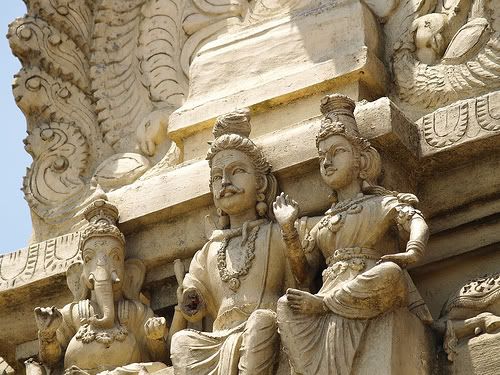

60 kms north of Bangalore is the summer resort called Nandi Hills. Also known as Nandidurga, it was one of the summer retreats of Tipu Sultan.
Nandi Hills was popular with the British too who built bungalows and laid out gardens here.
Today of course, it's a hot favourite among Bangaloreans who find this an ideal get-away for weekends. The 1478-m high Nandi Hills is the originating point of many rivers.
And the forests surrounding the hills, abound with wild animals. Around the Nandi Hills are several smaller hills, which can be visited on foot.
How To Get There
By Air
The nearest airport is Bangalore.
By Rail
The nearest railhead is Chikkaballapur.
By Road
Nandi Hills is connected by road to Bangalore and Chikkaballapur.
Places To Stay
Hotel Mayura Pine Top Nandi Hills.
Kolar District.
Guest House of the Horticulture Department.
PWD Accommodation.
Climate
Summer
Max: 29°C Min: 23°C.
Winter
21°C Min: 11°C.
General Information
Location
60 kms north of Bangalore, Karnataka.
Altitude
1478 m above Sea Level.
Main Attraction
Tipu's Drop, Yoga Nandishvara Temple.
Best Time
Throughout The Year.
Languages
Kannada, Hindi, English.
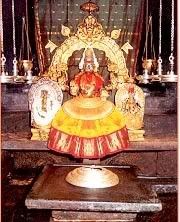
Sree Mookambika Devi Ashtakam
Namasthe Jagadatri Sadbrahma Rupe
Namasthe Haropendra Datryadivandye
Namastheprasanneshtadhanaikadakshe
Namasthe Mahalakshmi Kolapuresi
Vidhikrithi Vasa Harirviswmethath
Sijathyathi Patheeyathath Prasidham
Kripalokana Devathe Shakthirupe
Namasthe Mahalkshmi Kolapuresi
Thuayamayayapyapthamethathsamastham
Dritham Leelaya Devi Kukshu Hi Viswam
Sthithambudhirupenasarvathrajanthou
Namasthemahalakshmi Kolapuresi
Yayabhakthavargahi Lakshyanthaetho
Thouyatraprakamkripapoornadrishtya
Athogeeyasedevilakshmeerithithuam
Namasthemahalakshmikolapuresi
Punarvakpaduthuadiheenahimooka
Naraistharnikamkhaluprarthaseeyath
Nijeshtayathethasyamookambikathuam
Namasthemahalakshmikolapuresi
Yaduaditharoopathparabrahmnastham
Samuthapunarviswaleelodyamstha
Thadahoorjanasthamhigowreemkumarim
Namasthemahalskshmikolapuresi
Hareesadidehothejomayapra
Sfurachakrarajyakyalingaswaroope
Mahayogikolarshi Hridpadmagehe
Namasthemahalakshmikolapuresi
Namasankachakrayabishtahasthe
Namasthambikegowripadmasanasthe
Namaswarnavarneprasannesaranye
Namasthemahalakshmikolapuresi
Namasthe Jagadatri Sadbrahma Rupe
Namasthe Haropendra Datryadivandye
Namastheprasanneshtadhanaikadakshe
Namasthe Mahalakshmi Kolapuresi
Vidhikrithi Vasa Harirviswmethath
Sijathyathi Patheeyathath Prasidham
Kripalokana Devathe Shakthirupe
Namasthe Mahalkshmi Kolapuresi
Thuayamayayapyapthamethathsamastham
Dritham Leelaya Devi Kukshu Hi Viswam
Sthithambudhirupenasarvathrajanthou
Namasthemahalakshmi Kolapuresi
Yayabhakthavargahi Lakshyanthaetho
Thouyatraprakamkripapoornadrishtya
Athogeeyasedevilakshmeerithithuam
Namasthemahalakshmikolapuresi
Punarvakpaduthuadiheenahimooka
Naraistharnikamkhaluprarthaseeyath
Nijeshtayathethasyamookambikathuam
Namasthemahalakshmikolapuresi
Yaduaditharoopathparabrahmnastham
Samuthapunarviswaleelodyamstha
Thadahoorjanasthamhigowreemkumarim
Namasthemahalskshmikolapuresi
Hareesadidehothejomayapra
Sfurachakrarajyakyalingaswaroope
Mahayogikolarshi Hridpadmagehe
Namasthemahalakshmikolapuresi
Namasankachakrayabishtahasthe
Namasthambikegowripadmasanasthe
Namaswarnavarneprasannesaranye
Namasthemahalakshmikolapuresi
Location
Kollur, Kundapur Taluk, Karnataka State, India.
About 135 Kms from Mangalore, one of the major city in Karanata State. The nearest railhead is Udupi.
Kollur is well connected to Mangalore, Bangalore (Capital of Karnataka State) and Mysore. Regular buses are there from Udupi. Also Kollur is well connected with tourist centers such as Mangalore and Shimoga in Karnataka and Kannanur in Kerala.
About 135 Kms from Mangalore, one of the major city in Karanata State. The nearest railhead is Udupi.
Kollur is well connected to Mangalore, Bangalore (Capital of Karnataka State) and Mysore. Regular buses are there from Udupi. Also Kollur is well connected with tourist centers such as Mangalore and Shimoga in Karnataka and Kannanur in Kerala.
Significance
The main statue in the temple is the Shiva Linga called the Jyothirlingam. This Jyotirlingam in front of the image of the Goddess Mookambika is of great antiquity.
The great hindu religious leader Sri Adi Sankara was associated with this temple and is said to have spontaneously composed the classic work Soundarya Lahiri here. Sri Adi Sankara is said to have installed the metal image of the Goddess behind the Jyotirlingam. The idol that was installed by Adi Shankara is confined in a copper roofed and gold crested temples.
This well known temple is visited by pilgrims from all over India and overseas.
At the foot of the Western Ghats. It is is situated at the banks of the never drying river Sauparnika. It is a belief that an eagle (Garuda) called Suparna performed penance on the banks of the river and attained salvation hence the name Sauparnika. It is a pleasant experience to take a dip in the holy river and then head for the darshan of the goddess.
Kollur is one of the seven pilgrimages which were created by Parashurama. While the other pilgrimages created by Parashurama are devoted to Lord Shiva, Lord Subramanya and Lord Ganesha, this is the only one devoted to Goddess Parvathi.
There are couple of places worth visiting in the neighboring of the temple. One of them is Arasina Makki, a famous waterfall. The Kutachadri range is a beautiful place and attracts a large number of mountaineers and trekkers.
Kollur is regarded as one of the Seven Muktistala pilgrimage sites in Karnataka.
The great hindu religious leader Sri Adi Sankara was associated with this temple and is said to have spontaneously composed the classic work Soundarya Lahiri here. Sri Adi Sankara is said to have installed the metal image of the Goddess behind the Jyotirlingam. The idol that was installed by Adi Shankara is confined in a copper roofed and gold crested temples.
This well known temple is visited by pilgrims from all over India and overseas.
At the foot of the Western Ghats. It is is situated at the banks of the never drying river Sauparnika. It is a belief that an eagle (Garuda) called Suparna performed penance on the banks of the river and attained salvation hence the name Sauparnika. It is a pleasant experience to take a dip in the holy river and then head for the darshan of the goddess.
Kollur is one of the seven pilgrimages which were created by Parashurama. While the other pilgrimages created by Parashurama are devoted to Lord Shiva, Lord Subramanya and Lord Ganesha, this is the only one devoted to Goddess Parvathi.
There are couple of places worth visiting in the neighboring of the temple. One of them is Arasina Makki, a famous waterfall. The Kutachadri range is a beautiful place and attracts a large number of mountaineers and trekkers.
Kollur is regarded as one of the Seven Muktistala pilgrimage sites in Karnataka.
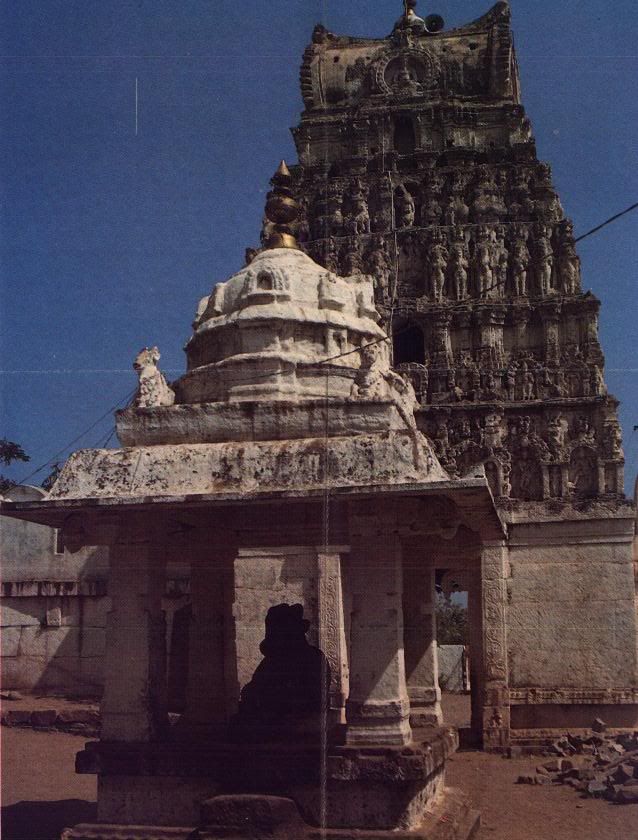
The name Markandeshwar is associated with Maharishi Markandeya, a great devotee of Shiva. The Markandeshwar Mahadev temple is located in the town of Shahbad Markanda, which is situated in the Kurukshetra district of Haryana in North India. Shahbad Markanda lies on the banks of the river Markanda, a tributary of the Ghaggar, and supposed to be a part of the ancient Vedic Saraswati River basin system. The river derives its name from Maharishi Markandeya as well and several ancient ashramas of Rishi Markandeya can be seen along the banks of the river in the neighboring districts.
Story of Maharishi Markandeya
Markandeya was an exemplary son, who was destined to die at the age of 16. He grew up to be a great devotee of Shiva and on the day of his destined death he continued his worship of Shiva in His form of Shivalingam. The messengers of Yama, the God of death were unable to take away his life because of his great devotion and continual worship of Shiva. Finally, Yama came himself to take Markandeya's life away and sprung his noose around the young sage's neck. By mistake, the noose landed around the Shivalingam and out of it, Shiva emerged in all his fury attacking Yama for his act of aggression. After defeating Yama in battle to the point of death, Shiva then revived him, under the condition that the young Markandeya would live forever. Thus, the Maha Mrityunjaya Stotra is attributed to Maharishi Markandeya.
History of the temple
The Markandeshwar Mahadev temple is supposed to be the place where the young Markandeya was praying to Shiva in order to win over his destiny. This is where Shiva fought with Yama and blessed Maharishi Markandeya with the boon of immortality. The original temple dated back to pre-Mahabharat times and was founded in the third millennium B.C. The current structure is more recent and dates back to the early 20th century.
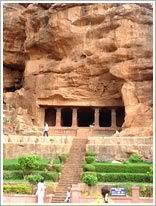
Badami situated in North Karnataka, the Capital of the Early Chalukyas. It is noted for its beautiful carved cave temples, artificial lake , Museme & rock-cut into the cliff face of a red sandstone hill, of the 6th & 7th Centuries. It is picturesquely situated at the mouth of a ravine between two rocky hills. Its all four cave temples - all hewn out of sandstone on the precipice of a hill. They display the full range of religious sects which have developed in India. Overlooking the temples is a reservoir, its banks dotted with temples. Two of them are dedicated to Vishnu, one to Shiva and the fourth is a Jain temple. The first three belong to the Vedic faith and the fourth and natural cave is the only Buddhist temple in Badami. Here are some splendid carvings of the Hindu Pantheon. Narasimha the half-man half Lion avatar of Vishnu Hari Hara, the composite god who is half-Shiva and half-Vishnu. Vishnu Narayana sitting as well as reclining on the snake Shesh or Ananta (Eternity )… There are also some painting on the ceiling and wonderful bracket figures on the piers. The caves found here are as follows:
Cave 1:
One can easily climb to cave 1 made of red sandstone. It antedates 578 A.D. and was probably the first to be carved. Climbing the 40 odd steps to reach the colonnaded verandah, a hall with numerous pillars and a square shaped sanctum hollowed in the control backwall. Column shafts are masterfully crafted. On the ceiling one can see the paintings of amorous couples. Shiva and his consort Parvati, and a coiled serpent. Shiva as Natraja with 18 arms is seen in 81 dancing poses.
Cave 2:
This cave is dedicated to Vishnu. Vishnu here is depicted as a dwarf or Trivikrama of awesome dimensions with one foot mastering the Earth and the other the sky, the second cave is atop a sandstone hill. Vishnu here is depicted as a dwarf or. Another form of Vishnu portrayed here is as 'Varaha' or as a boar. Vishnu riding the Garnda & lotus surrounded by sixteen fishes.
Cave 3:
Still going higher up one comes across this 578 A.D. The facade of the cave is nearly 70 feet wide, on the plinth one can see the carvings of ganas. The sheer artistry and sculptural genius makes it this cave the highlight of Deccani art. It gives a virtual insight into the art and culture of the 6th century like costumes, jewelry hairstyle lifestyle etc. The other attractions to be looked carefully in this cave are the high relief of Vishnu with a serpent, Vishnu as Narasimha (Vishnu as Man-Lion) Varaha, Harihara (Shiva Vishnu) and Vishnu as Trivikrama.
Cave 4:
Lying to the east of cave three, the fourth cave is Jain. There is an image of Mahavira adorning the sanctum. Other carvings here are of Padmavathi & other Thirthankaras. Asteep climb up some steps cut in a crevice between Cave II & III leads to the southern part of Badami Fort & to an old gun placed there by Tippu Sultan.
Architure
The cave temples of Badami which date back to 600 and 700 A.D. are carved out of sandstone hills. Each has a sanctum, a hall, an open verandah and pillars. What makes these cave temples remarkable, are the large number of exquisite carvings and sculptures. The town encompasses a number of carved monuments and caves of the Chalukyas that is a blend of Indian Nagara style and the South Indian Dravidian style of architecture. There are many beautiful murals as well. The free standing stone temples in Badami, provide enlightening information about the development of the Chalukyan style of architecture, as many seem to have been experimental constructions. The early temples appear to be like large court halls to which shrines were attached. The Ladkhan temple at Aihole belongs to this early phase. The next phase of development is visible in the Gowdaragudi temple which is a more complex structure.
One of the many masterpieces to be found in these caves is the famous, 18-armed Nataraja (Shiva) who if observed closely, strikes 81 poses. Cave 4, the last cave, is the only Jain Temple in Badami. The 24th Tirthankara- Mahavira, is seated in a uniquely comfortable pose here, against a cushion in the inner sanctum. On the other bank of the ancient Bhutnatha lake, astride whose shores the caves stand, is the shrine of Nagamma, the local serpent goddess, within a massive tamarind tree. Nearby, are two Shiva temples, which deify Him as Bhutanatha, God of Souls. Within the inner sanctum, on the edge of the water, He sits in a rare pose, leaning back, in all his awesome majesty. It is said that the better known caves of Elephanta and Ellora were modelled on the ones in Badami. The Kailashnatha temple at Ellora, has been hewn out of an entire hillock, cut out from the parent hill and combines the best of cave and free-standing temples.
History
The rich past of Badami is closely linked with the ancient Kingdom of Chalukyas. It was first founded by Pulakesin I in the 6th century A.D. The Chalukyas are to be credited with pioneering a new architectural style, examples of which can be seen in Aihole, Pattadakal ( one comes across Banashankari, the goddess the village is named after) and other neighbouring areas. It was also ruled by the Chalukyas of Kalyan (a separate branch of Chalukyas), the Kalachuryas, Yadavas of Devangiri and the Vijaynagar Empire. In the latter medieval period, Adil Shahi rulers of Bijapur and the Marathas ruled it. Badami was finally taken over by the British, who made it a part of the erstwhile Bombay Presidency. They built a number of temples, and other monuments that marked the beginning of the Hindu style of architecture. This new style combined the best of two distinct styles - the North Indian, Indo-Aryan Nagara style and the South Indian Dravidian style. Known as the Chalukyan style, this style is manifested in many cave temples, dedicated to Brahmanical deities, as well as the many Buddhist and Jain monasteries in the region.
Places to see
Naganath Temple
10 Kms, located in a forest on the way to Mahakuta, it is one of the early Chalukyan temples dedicated to Shiva.
Aihole
46 Kms. There is a remarkable group of temples here built during the reign of Chalukyan rulers, dating from the sixth to the eighth centuries.
Tranquil lake
Take a dip in this green tranquil lake. It is said to have healing properties. According to a popular story, King Kushataraya was cured of leprosy here.
Archaeological Museum
Museum with Shiva's bull, "Nandi" at its entrance overlooking the dammed lake is worthwhile for the scholarly. This museum is closed on Fridays.
Badami Fort
2 Kms. Strategically situated on top of the hill, the fort encloses large granaries, a treasury impressive temples on top of the northern end of the hill. Malegitti Shivalaya, perhaps the oldest temple of the lot, is dedicated to the benign aspect of Shiva as the garland maker. Placed on the summit of a rocky hill, the temple is built of stone, finely joined without mortar, & with Dravidian tower. The lower Shivalaya has a Dravidian tower of which only the sanctum remains now.
Main attarction
A number of annual temple festivals are held in towns near Badami. The annual temple festival, held at Banashankari, in the month of January-February is worth visiting; so are the Virupaksha Temple Car Festival and Mallikarjuna Temple Festival held in Pattadakal during March-April.

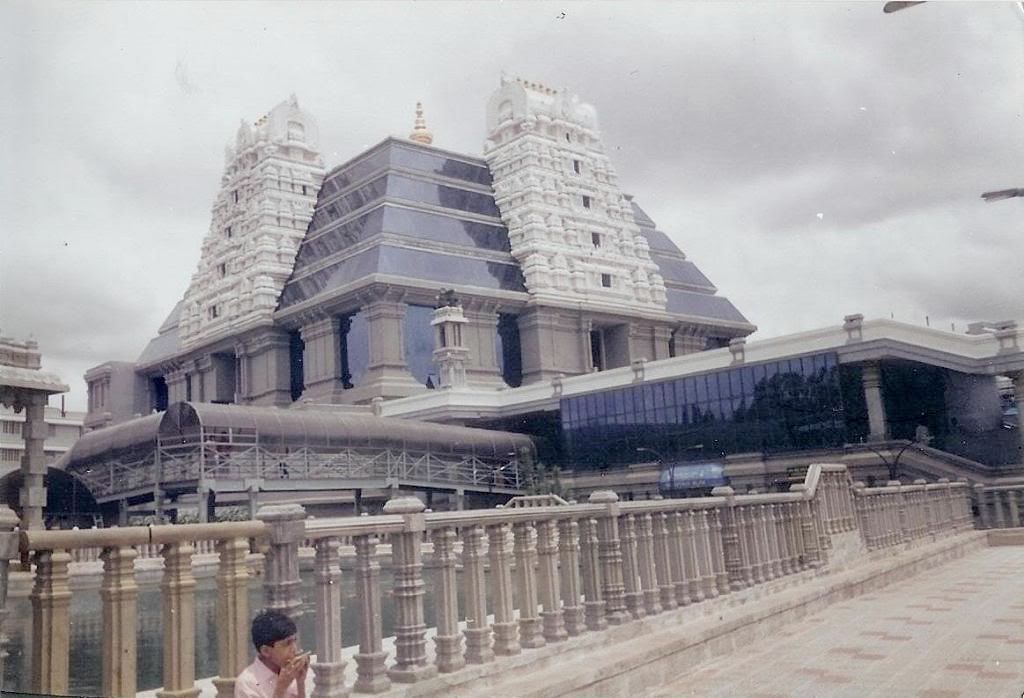
Bull Temple was constructed in 16th century and is dedicated to a sacred bull - Nandi carved out of a single granite block. The temple is a typical specimen of Dravidian architecture. Kallekai parse an annual festival is celebrated at the time of harvesting of peanuts during the month of Nov-Dec, thousands of visitors throng the city to participate in the festival from all over the state.
About The Bull Temple
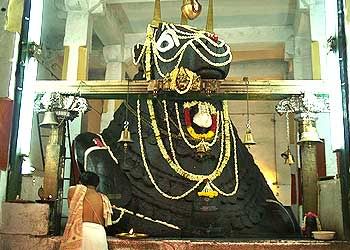
The "Bull Temple" is situated in Bangalore - the capital of Karnataka. The sculpture of bull is the holy deity in the temple, also known as "Nandi Temple". The gigantic bull measuring 4.57m in height and 6.10 m in length is carved out of a single rock. It is a sculptural magnum opus.
This Bull Temple is dedicated to Lord Shiva's Vahana (vehicle), Nandi the bull. Large number of devotees visits the enormous monolithic statue of the sitting bull every day.
Nandi the bull of Shiva faces the temple of Lord Shiva haunch at the back with sculptures of God Surya and Goddess Candra on their chariots drawn by horses. There is a small Lingam shrine bedecked with the exquisite Gopuram. The underground "Sri-Gavi Gandadhareshwara Temple" holds its own charm, every year on 14th January known as Makara Sankranti festival, it is believed that a ray of light passes between the horn of a Nandi outside the temple and lights the idol kept inside. The Bull temple is full of liveliness during the Shivratri festival.
Non Hindus are not allowed in the temple. There are continuos festive celebrations throughout the year assisted by the musical programs held in the temple premises.
Timings: Entry to the temple is free and the daily timings are from 6a.m. to 8 p.m.
Legend
The legend has it that the surrounding area of the temple, known as Sunkenahalli was cultivated for groundnut. A bull started grazing in the well-grown groundnut crop, at this, a farmer got furious and hit the bull with a club. Immediately the bull sat down becoming motionless and was transformed into a stone. Poor farmers were left stun and felt guilty. For their repentance they decided to build a temple for the bull, to their surprise the bull was growing in height. The worried farmer then prayed to Lord Shiva who advised them to redeem a trident buried a few feet away from the bull and place the trident on the forehead of the stone statue to stop it from growing. Farmers followed the Lord's advice and the bull stopped growing. Still one can see the trident place on bull's forehead.Since then farmers offer their first crop of groundnut to the bull. The farmer's hold a Groundnut fair known as Kadalekayi Parishe, near the temple premises every year, to show their thankfulness. It is one of the worth visiting places in Bangalore.
Architecture
The temple is a typical specimen of the Dravidian-style of temple architecture constructed by Kempe Gowda. The temple is nestling in Basavanagudi housing a scared bull of Lord Shiva, it is believed that the source of the river Vishwa Bharathi originates from the feet of the Nandi. There is a Ganesh temple inside the premises with a large deity all made of 110 kilos of butter. The deity of butter is distributed as a prashada (God's food) every four years.
Farmers offer the first groundnuts to the sacred bull. The Bhoganandiswara temple at the foothills of Nandi Hills goes back to the period of the Banas, Cholas, Hoysalas and the Vijayanagar Kings. The image has been carved out of single granite rock. The original color of Nandi bull was gray which has now turned black due to the application of coconut oil by the devotees.
Festivity
Anually, Kadalekayi Parishe -the Groundnut Fair is held near the temple during the month of November- December when the groundnut crop is harvested. Farmers offer the first groundnuts harvest to the sacred bull. Thousand of visitors and devotees throng the temple site from all over the state.
Accessibility To The Bull Temple
The Karnataka State Road Transport Corporation (KSRTC) bus regularly operates from the all over the state to the Park. Coaches of B.T.S., I.T.D.C., are also available. Tourist coaches and taxis are also available for the park.

Deity: Amareswara (Shiva)
Legend: According to Skanda Purana tells the story of the temple. The Sthalapurana for the temple tells an interesting story. At the end of Dwaparayuga 5053 years ago, Maharshi Narada was asked by the Sounakadi rishis as to the best means to obtain liberation. Narada told them that as Lord Krishna had created the river Krishna, so had he advised the rishis to live near the river and bath in its holy water to attain salvation. If a devotee remains in this area for more than three days and worships Lord Amareswara with devotion after a dip in the holy river he will attain the Sivaloka.
If a devotee dies here, he will be absorbed into Lord Siva. There are many more legends from the Kshetra Mahatmyam and the Kshetramurthy Mahatmyam. Once there was a town called Dhanyakatakam or Varanasi. The legend says the demons defeated the gods after being awarded a boon by Lord Siva. Shiva vowed to kill the demons and hence the gods came to reside here and since then the place came to be called Amaravati. The Lord Amareswara is worshipped here with his consort Bala Chamundika who is considered as the fourth of the 18 goddesses. There are other minor deities in the temple.
This ancient temple is dedicated to Shiva and enshrines a 15 feet high white marble lingam and is surrounded by massive walls with towers. The temple stands close to the Krishna River. The origin is shrouded in mystery, though there are many legends in the Puranas. The temple is surrounded on four sides by towering gopuras in Dravidian style. The vimana is also in the same style.
Legend says that the temple was originally Buddhist and was adapted for Hindu worship. Hence the foundations are laid in Buddhist style. The mula virat in the sanctum one can still find a white marble lotus medallion made in ornate style of the early Buddhist sculptors. The mula virat is a vertical cylinder made of white marble as found in Buddhist monuments.
The linga is 15 feet tall, another legend states that this was originally the Ayaka Stambha or an Ayaka pillar, and which was later consecrated as a symbol of the Sivalinga. The temple is a perfect example of the Dravid style. The gopuras came into prominence only during medieval times and no stone epigraph is found before the 11th century suggesting its late origin. There is a wealth of inscription on its walls by Kota chiefs of Amaravati, and one by Krishandevaraya on the erection of a mantapam here. On a pillar in the Mukhamantapa the wife of Proli Nayudu, dependent of Koppara Kesanivarma, has left an inscription.
Festivals: The main festivals here are Mahashivratri, which comes in the Magha Bahula Dasami and the Navaratri and the Kalyana Utsavas.
Getting There
Amaravati can be reached either by bus from Guntur or by steam launch from Vijayawada across the river Krishna.

Talupulamma Talli temple is the most famous and well known place in Andhra pradesh as each and everybody visit for offering pooja to the Goddess after purchasing a new vehicle. There are hardly any people in Andhrapradesh who don't know about this Goddess and each and everybody insist on coming and having darshan of the Goddess after owning a new vehicle. People offer goats, chicken/hen in this place. The temple is situated in between a hill and surrounding is very scenic. This makes an excellent picnic spot too for those who wants to spend their week end.
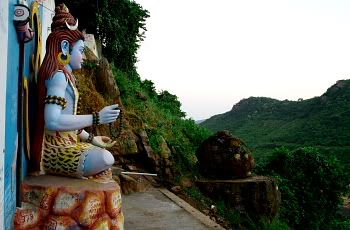
halupulamma Talli temple is in Visakhaptanam district of Andhra Pradesh in India. The place is situated between Tuni and Annavaram. Tuni is 100Kms from Visakhaptanam towards Rajahmundry. After Tuni continue the journey towards Annavaram and take right turn near an arch indicating the name of the temple. From the arch the temple is just 5Kms. On the way visitors pass through some extremely beautiful landscape area and can enjoy the nature. Nearer to the temple the road is steep and few sharp curves exist. Vehicles go nearer to the foot step of the temple. There are steps to be climbed up to reach the temple premesis.
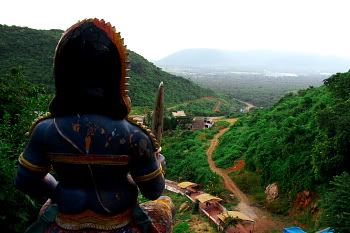
Travellers coming from Vijayawada or Rajahmundry side have to reach Annavaram on National High 5 by travelling towards Visakhaptanam. 10Kms after Annavaram take left turn near the arch and travel another 5Kms to reach the temple. Visitors or devotees who wish to cook non vegetarian food during their vehicle puja ceremony can be done as there will be lot of people selling chicken and goats locally. They arrange everything for cooking the food on rental basis. Once the puja and food is over, the leaft out things will not be carried by the devotees, they leave everything or give those to local people and go.
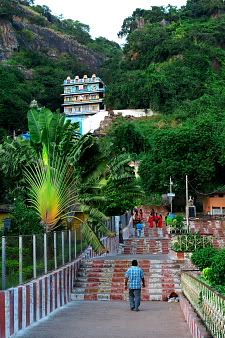
The temple is opened upto 6.00pm only. Make sure that you reach well in time so that Talupulamma Talli darshan can be had. Nobody stays after 6.00pm and normally people return from this place and travel towards either Annavaram or Tuni to find accomodation. If you are travelling to visit Annavaram, make it sure to include this place in your travel plan, it will not disappoint you. Just 30 to 45 minutes of time is sufficient to visit this place and return. People have very stong belief on this Goddess for the reason that, anything they wish to do, will become a success after visiting this temple.
One can see the vehicle numbers written on the stones surrounding the temple though it is strictly prohibited. The temple is well maintained and very clean and neat.
Only bus transportation is possible. Special bus service is available. Nearest railway station is Tuni and Annavaram. Make sure that the trains give stop in these stations before boarding as this is a two way broad gauge route and most of the trains are super fast. Road transportation is available from Tuni and Annavaram. Better to rent a vehicle and visit the temple as it is nearer to both Tuni and Annavaram. Travellers can also visit Samalkot where one of the Pancharama temple, Bheemeshwara Kumararama, is situated.

Ryali
Ryali is situated in East Godavari district (Atreyapuram Mandalam) of Andhrapradesh - India. This area is also called Kona Seema, a purely well irrigated area of Andhrapradesh due to many tributories of river Godavari. The famous Sri Jagan Mohini (Sri Maha Vishnu) temple is situated here. The shrine of Sri Jagan Mohini Keshava Swamy is made up of single stone (Salagrama Ekashila - 5 feet height and 3ft width). The idol looks like Sri Vishnu (male) from front side and as Mohini (female) from rear side. The architectural beauty of the idol and temple is excellent. The flow of Akasha Ganga at the feet of Sri Maha Vishnu can be seen here.
This place was purely a wild forest during 11th century and was ruled by Cholas. Raja Vikrama Deva originally constructed a small temple during 11th century and later renovated.
How to reach

Ryali is located in East Godavari district of Andhrapradesh - India. Tourists travelling fron Northern part of India have to come to Visakhapatnam via National Highway 5 (Highway between Kolkata and Chennai) and proceed towards Tuni, Annavaram and Rajahmundry. From Rajahmundry, travel towards Dowlaiswaram Barrage and take left turn at Bobbarlenka (immediately after the barrage on river Godavari). From Bobbarlanka proceed towards Lolla and take right diversion at Merlapalem to reach Ryali. The distance between Rajahmundry and Ryali (Rali) is 25 Kms. People travelling from South and other parts of India have to reach a place called Ravulapalem on National Highway 5 (before Rajahmundry). At Ravulapalem take right turn to proceed towards Merlapalem and take left turn here to reach Ryali.
Importance of Ryali

n local language (Telugu) Ryali means FALL. As per Bhagavatam, Lord Vishnu takes the guise of Mohini to rescue Devatas against Rakshasas during Samudra Mathana for getting Amrutam (holy devine nectar). During equally distributing the Amrutam among Devatas and Rakshasas, Mohini works in favour of Devatas and avoids the nectar by giving to Rakshasas. Lord Eshwara (Shiva) sees Mohini and falls in love with her. Lord Shiva comes to know that Mohini is the guise of Lord Vishnu when a flower falls from the plait of Mohini. This place where the flower has fallen is named RYALI meaning FALL in Telugu.
In Ryali Lord Shiva is worshipped as Uma Kamandaleswara because on the back side Lord Brahma Consecrated the Siva Lingam with his Kamandalam. The Mahavishnu is consecrated as Mohini at the back side and hence worshipped as Sri Jaganmohini Keshava Swamy. The temples of Lord Shiva and Lord Vishnu face each other in East and West direction, a rare feature to see at Ryali. The shrine of Sri Jaganmohini is a joy to see. The ten incornations of Lord Sri Vishnu and consorts are beautifully sculptured around the shrine.
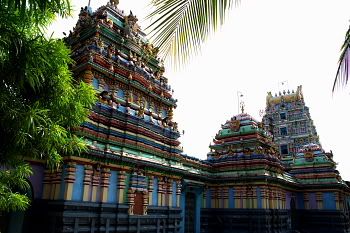
he temple timings are from 6.00am to 12.00noon and from 3.00pm to 8.00pm. No photography allowed inside the temple. Better plan to have food and stay at Ravulapalem as Ryali is a small village. People can include other places like Vadapalli (Lord Venkateswara temple), Pancharama temples (4 in this area, Samalkot, Draksharama, Palakollu, Bheemavaram) in their trip plan for visiting as these are all nearby.
There is no standard package to visit Ryali from any of the travel agents. The nearest Railway station is Rajahmundry and nearest airport is Visakhapatnam. Plan for hiring a private vehicle to visit places in Konaseema.
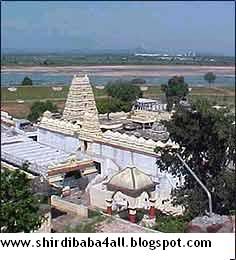
Bhadrachalam
Bhadrachalam is one of the major pilgrim centre in Andhra Pradesh for Hindus. This city is famous for the temple of Sri Rama built by Bhakta Ramadasa during 1630 AD. Ramadasu was a devotee of Lord Rama. The temple has been constructed beside the banks of river Godavari and has been renovated recently. Situated in Khammam district of Andhra Pradesh, the place is also surrounded by Chattisghad and Orissa states. There will be a festival in each year during the month of April (Rama Navami day) in Bhadrachalam.
Reaching Bhadrachalam
Reaching Bhadrachalam
Bhadrachalam is situated 120Kms from Khammam and 320kms from the Andhrapradesh state capital Hyderabad. Hyderabad is the nearest town for airport. Nearest railway station is Kothagudem located just 40Kms away. This railway station is mainly meant for Singareni coal mines and hence passenger trains from Khammam are limited. This is the end station. The convenient train traffic is more for Khammam head quarters itself. Many tourists prefer visiting Bhadrachalam via Rajahmundry by launch journey in the river Godavari. This one is a twelve (12) hours journey in the river between Rajahmundry and Shri Ramagiri. And two hours bus journey between Sri Ramagiri and Bhadrachalam via Konavaram.
Visiting places in Bhadrachalam
Visiting places in Bhadrachalam
The main attraction of Bhadrachalam is Sri Rama temple. The temple timings are from morning 4.30am to 5.00am. Temple reopens at 7.00am and will be opened till night 9.00pm. It is believed that Sri Rama, Laxmana and Sita stayed nearer to Bhadrachalam in a place called Parnashala, 35kms from Bhadrachalam. It is from this place Ravana kidnapped Sita. On the way to Parnashala to the left, crossing the river Godavari, a small water falls can be seen which is quite a pleasant place. One more water falls called Kinnerasani is located approximately 40Kms from Bhadrachalam. A well known paper mill (Bhadrachalam Paper Boards Limited) is situated nearer to Bhadrachalam (7-8 kms away).
Accomodation and food at Bhadrachalam
Accomodation and food at Bhadrachalam
Temple accomodation nearer to the temple are available at a very reasonable rate. People who want a better kind of lodge can opt for private hotels. Budget hotels starting from INR 300 are available. It is possible to have booking the hotels for both temple and private in advance. Good south Indian food is available

Also referred to as the Dakshina Kashi (southern Kashi) locally, Antarvedi has importance of having a tributory of river Godavari meeting the sea (Sagara Sangamam). Whereas the temple of lord Sri Lakshmi Narasimha Swamy is located at the other side, almost nearer to the bank of Godavari, also called, Vasishta Godavari. There is also a light house near the meeting point but there is no way to reach the place. Antarvedi is in the East Godavari district of Andhrapradesh state in India, situated at the interior part at East coast. The surrounding is rich with irrigated land because of several tributories of river Godavari. Speciality of Sri Lakshmi Narasimha Swamy temple is that, the God is facing towards West instead of East (usual direction of other temples in India). Vashishta Sevashram is available nearer to the river where one can have a trip to a small island.
How to reach

Antarvedi is located at the East coast of Andhrapradesh and is remotely situated in East Godavari district of Andhrapradesh - India. People travelling from North India have to reach the main city called Annavaram on National Highway - 5, Kolkata - Chennai connecting road, after Visakhapatnam. Tourists have several choices from Annavaram to reach Antarvedi. Travellers can travel Upto to a place called Kathipudi, 12Kms from Annavaram on NH-5 and take left turn to proceed towards Kakinada (40Kms from Kathipudi). One more way to reach Kakinada is to proceed upto Samalkot and going towards Kakinada.
There are boats available to reach Antarvedi from Narasapur. The distance is only 10 Kms.
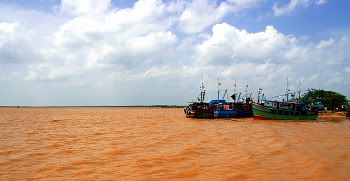
Tourists willing to visit Pancharama temples can reach Samalkot and Ramachandrapuram ( Draksharama on the way to Kakinada from Samalkot) where both the places have one of Sri Rama temple. Travellers can then proceed towards Yanam (under Pondicerry, an Union Territory, 27Kms from Kakinada). From Yanam, continue the journey towards Mummudipalem (15Kms from Yanam), Amalapuram (16Kms from Mummudipalem), Ambajipit (8 Kms from Amalapuram), Gannavaram and Rajole (30Kms from Amalapuram). From Rajole, Antarvedi is 30Kms. People have to take left turn in the road proceeding to Palakollu to reach Antarvedi.
People travelling from Vijayawada and Krishna district of Andhrapradesh, have to reach the place called Bheemavaram first. Bheemavaram and Palakollu have Sri Rama temples which are considered as Pancharama temples. They can add these two places in their visiting places while visiting Antarvedi. From Palakollu, travel towards Rajole. Before reaching Rajole, take right turn to proceed towards Antarvedi.
Importance of Antarvedi

he main attraction of Antarvedi is the sea meeting point of river Godavari (a tributory) to Bay of Bengal. This is one of the place in Kona seema (East Godavari district of Andhrapradesh - India). Vasishta Sevashram is located just nearer to the river Godavari. Hence this tributory is called Vashishta Godavari. Opposite to Vasishta Godavari, Lord Sri Lakshminarasimha Swamy temple is located. Nearer to Lakshminarasimha Swamy temple, Lord Shiva temple is also located (Neelakanteswara, Brahma stapana). Launch facility is available to visit a small island at the other bank of the river Godavari (bank of Brother and Sister). The Mahameru Sahita Sri Kurma pratishtapana of Vasishta devalayam was done during 2005-06.
There will be a fair during January or February (Bhishma Ekadashi day) when Lakshmi Narasimha swamy kalyanam is celeberated. Devotees in huge number attend and take holy dip at the sangamam (Saptha Sagara Sangamam).

Tourists can even travel till the end of the sea and river meeting point if interested. The cost varies depends on the number of people. If limited number of people are willing to visit the island, a nominal amount of INR 350 will be charged. If more number of people are available, INR 50 will be charged for each person.
No standard package is available to visit Antarvedi from any of the travel agents. Tourists have to plan their trip personally. Additional places to visit in this area are Palakollu, Bheemavaram, Draksharama, Samalkot. These four places include one each of the Shiva temple considered as the Pancharama temples (Kumara Rama, Daksha Rama, Soma Rama and Ksheera Rama). One more temple is situated in Amaravati at Guntur district (Amara Rama).
No food is available at Antarvedi. People have to plan at either Rajole or Amalapuram for their stay. Good South Indian food and budget lodges are available in these places. Train facility is available to reach Kakinada, Rajahmundry, Samalkot. Nearest airport is Visakhapatnam.
There is a monthly magazine available and the subscription can be taken by the Manager of the temple. The magazine is related to Yoga, Education and science. Yearly subscription is INR 150. One can avail this facility through post also. Below is the contact address.
Editor,
Antharvedi Monthly Magazine,
Sri Vasishta Sevashram,
Vasishta Thapobhoomi,
Devasthanam Post,
Antharvedi,
East Godavari District-533252
Contact phone number: 9866223812, 9866220428,
Manager: K.V.S.L. Narasimharaju










This comment has been removed by the author.
ReplyDeletesri sri sri adisanakaracharya was born around 400-500B.C and not 8 A.D.
ReplyDelete